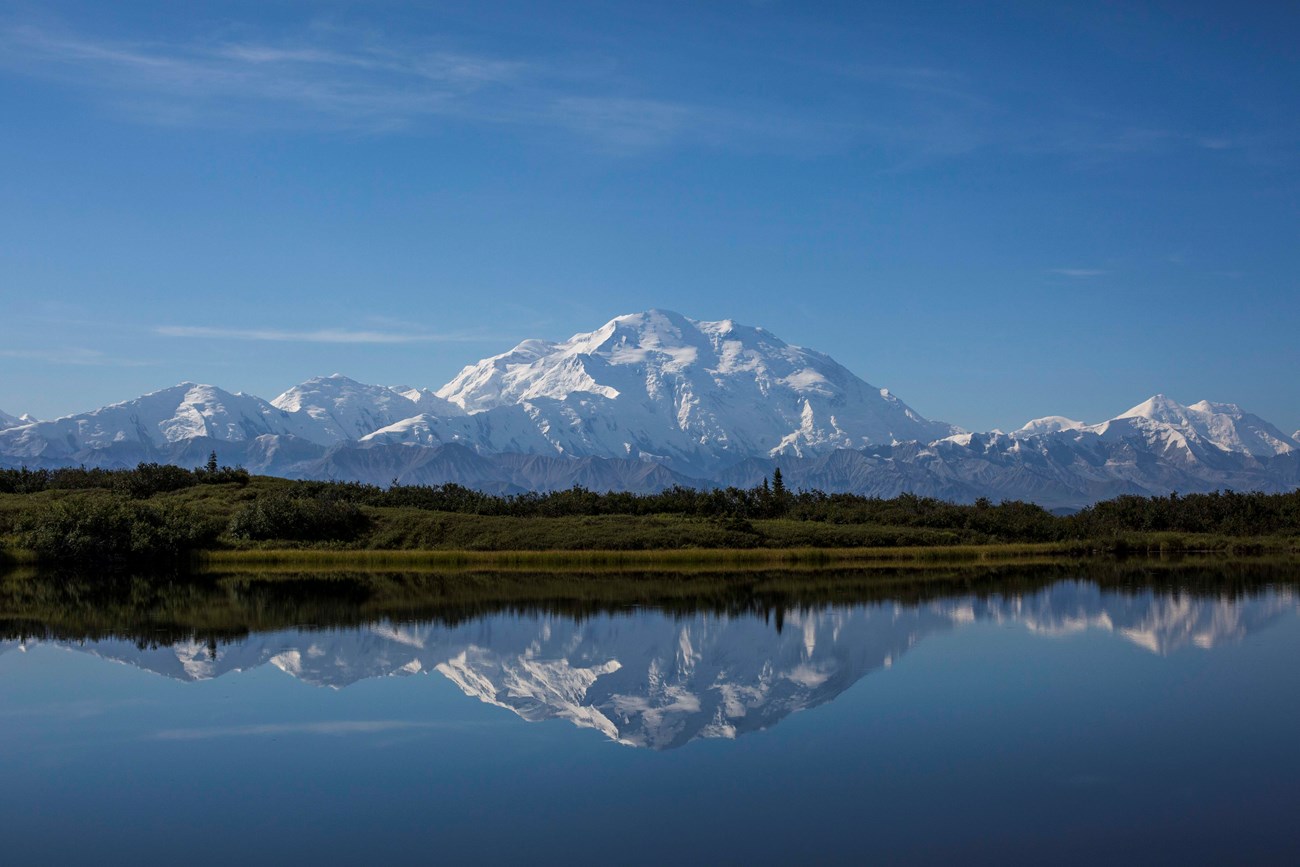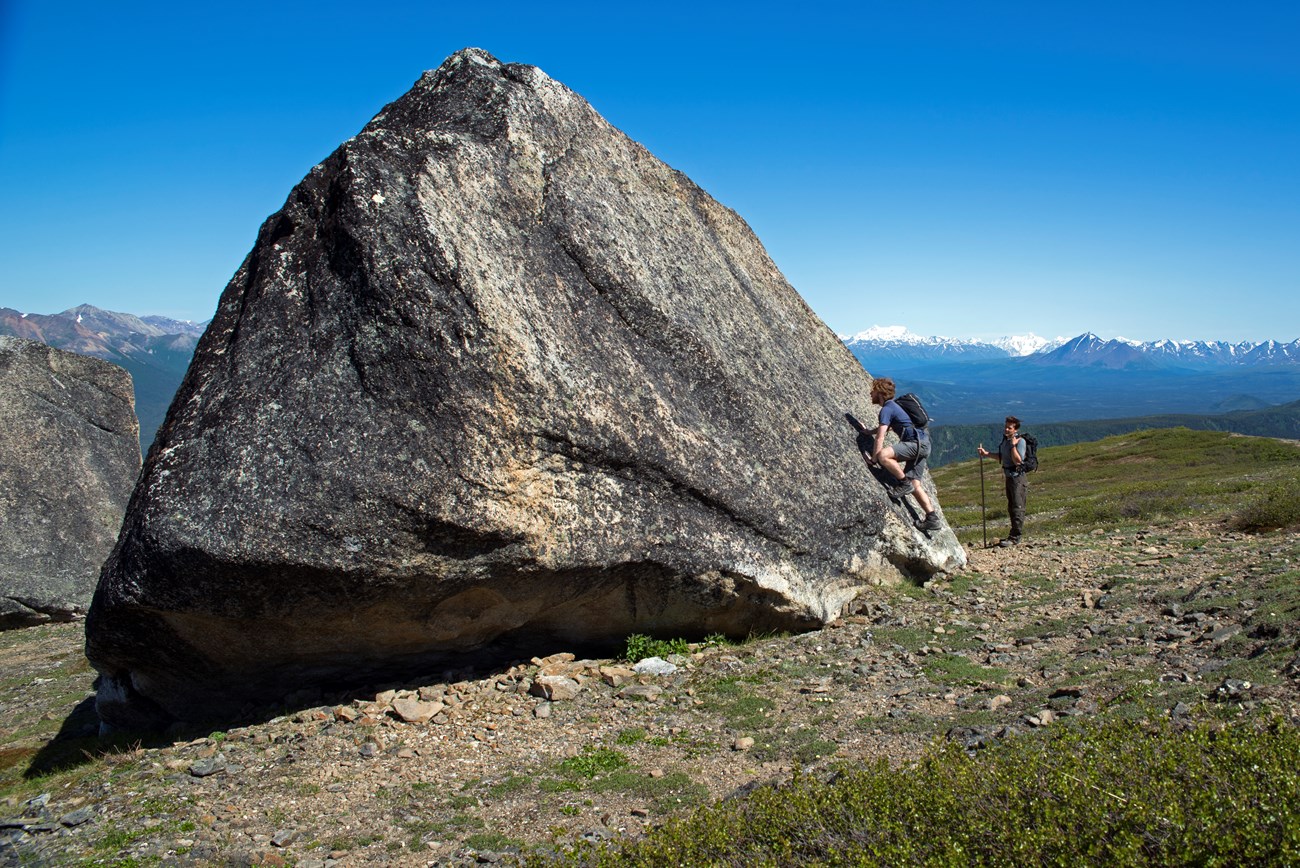Last updated: January 31, 2025
Article
The Alaska Range and Mount McKinley: Geology and Orogeny
Mount McKinley is one of the most striking features on the entire planet. At 20,310 feet, it is the crowning peak of the Alaska Range and the highest mountain on the continent. It towers three and one-half vertical miles above its base, making it a mile taller from base to summit than Mt. Everest. Mount McKinley's base sits at about 2,000 feet above sea level and rises over three and one-half miles to its 20,310 foot summit. Everest begins on a 14,000-foot high plain, then summits at 29,028 feet.

NPS Photo

NPS Photo
Land of Eternal Winter
Many consider Mount McKinley to be the world’s coldest mountain because of its combination of high elevation and its subarctic location at 63 degrees north latitude. Mount Everest (29,028 feet) is the world’s highest point above sea level, but it is at the same latitude (28 degrees north) as Florida’s Walt Disney World. Mount McKinley sits 2,400 miles further north. This makes an enormous difference in temperature.Mount McKinley is so massive that it generates its own weather; much the way a huge boulder submerged in a river creates whitewater rapids. All mountains deflect air masses and influence local conditions, but Mount McKinley rises so abruptly and so high that this effect is more dramatic here than perhaps anywhere else on Earth. Storms barrel in from the Gulf of Alaska and the Bering Sea and collide with Mount McKinley’s towering mass. Weather can quickly change from sunny and clear to blizzard conditions with fierce winds, intense cold, and heavy snowfall. Climbers must understand and pay close attention to warning signs of changing weather, and use their observations to plan when to climb, when to retreat, and when to dig in.

USGS Graphic
The Birth of a Mountain Range
The spectacular mountains we see today are a result of millions of years of rock formation, uplift, and erosion. Before we discuss the processes that created today’s Alaska Range, let’s review some basics about rocks and their origins.
Three major types of rocks make up Earth’s crust. Igneous rocks are formed when molten rock solidifies. Igneous rocks can be plutonic or volcanic. Plutonic rocks, such as granite, form when magma cools slowly in the depths of the earth. Volcanic rocks, such as basalt, rhyolite, and andesite form when lava cools rapidly on the surface.
Sedimentary rocks are derived from sediments—particles of mineral and organic material which have been deposited by water or wind. Sediments are most commonly carried by rivers or streams and deposited in basins, that is, low areas such lakes and seas. These sediments are buried and compressed into rock strata. Typical sedimentary rocks include sandstone, limestone, shale, and chert. Fossils found in sedimentary rocks provide clues to ancient environments.
Metamorphic rocks are pre-existing rocks that have been changed due to intense heat and/or pressure deep within the earth without completely melting. The original rocks could have once been sedimentary, igneous or even another metamorphic rock.
When rocks are squeezed and baked beneath Earth’s surface or by contact with lava at the surface, the minerals may recrystallize and change form. Wavy layers of minerals called foliation may appear. Typical metamorphic rocks around Denali include schist, slate, quartzite, and marble.

USGS Graphic
How Did Mount McKinley Get So High?
Geologists have identified several factors that have probably contributed to Mount McKinley’s great elevation. The theory of plate tectonics provides part of the answer. To briefly tell this story, consider that Earth’s crust is broken into great slabs of rock called tectonic plates. These plates float on the layer of Earth known as the mantle. The mantle is mostly solid, although it can move very slowly. Heat from the outer core is transferred to the lower regions of the mantle. As the mantle heats, it becomes less dense. This less dense material begins to rise. The cooler mantle under the crust is denser; it sinks. As it sinks, it warms, setting up a cycle called a convection current.
Geologists surmise that the convection currents in the mantle cause the tectonic plates on top to move around the surface. One tectonic plate, known as the Pacific Plate, forms the floor of the Pacific Ocean. It is slowly moving northward at about the rate that your fingernails grow. Oceanic plates are denser than continental plates. When an oceanic plate collides with a continental plate, the oceanic plate sinks below the continental plate in a process called subduction. In the diagram below, the Pacific Plate is diving below the part of the North American Plate that holds Alaska’s mainland. As the Pacific Plate moves northward, it carries chunks of land and pieces of other plates, some from thousands of miles away. These chunks and pieces are called terranes.

NASA Graphic
Much the way the hood of a car buckles under the force of a collision, the process of subduction causes the uplift of the Alaska Range, as well as the coastal ranges. There are two major faults that contribute to the uplift of Mount McKinley. They are the Denali Fault and the Hines Creek Fault. Land south of the faults moves to the west relative to the north at a rate of about 1 centimeter per year. A large bend in the Denali Fault directly north of Mount McKinley causes rocks to bunch up. Mount McKinley happens to be in this bend; this is one of the reasons it is so tall. The forces that caused the uplift of Mount McKinley continue today.
Scientists know that Mount McKinley rises at a rate of one half of a millimeter per year. That may not seem like much, but at that rate it will rise one kilometer in the next two million years—a brief period in geologic time. Its composition is another reason that Mount McKinley has grown to such a great height. It is mainly igneous rock granite. Mount McKinley’s granite formed below the Earth’s crust as part of a batholith. A batholith is a bubble or mass of magma within Earth’s crust. Plutons are parts of batholiths, defined by their chemical composition.
The chemical composition of the magma determines the type of rock that will crystallize. Other intrusive igneous rocks (rocks that cool within the crust rather than at the surface) include gabbro, diorite, and pegmatite. Granite usually happens to be less dense than much of the rock that surrounds it. Over millions of years, a granitic pluton will float slowly towards Earth’s surface, as it has in the case of Mount McKinley. Mount McKinley sort of “popped” up to the surface, much like a cork held under water will pop up when released. Just remember that “popping up” can take millions of years! Erosion of Earth’s surface rocks also helped expose the granitic rocks that make up Mount McKinley. Granite is also very resistant to erosion. The forces of erosion, that is water, ice and wind, have a hard time wearing Mount McKinley’s rock away. The rock pushes up faster than it is eroded, so Mount McKinley continues to grow. Subduction, uplift, and the lack of erosion have all contributed to Mount McKinley’s great height.
Weathering and Erosion
Even as the uplift of the Alaska Range continues, weathering and erosion are constantly working to tear it down. Weather and water, in the form of wind, rain, frost, streams, rivers and glaciers, have the power to turn mountains into molehills.
In brief, weathering crumbles rocks and minerals apart into smaller pieces. Erosion carries these pieces away by water, wind, glaciers, and gravity, often transporting the pieces for long distances. In Denali, ice is the predominant mechanism of erosion.
A Land Sculpted By Ice

NPS Graphic
In the high, frozen regions of the Alaska Range, snow and ice are the main forms of precipitation. In the past, most of the snow and ice remained behind; very little melting occurred. Snow and ice accumulated and got deeper and deeper, year after year, until the mass of ice that formed was so thick it compressed under its own weight. Gravity caused this ice to flow through stream valleys as glaciers. Glaciers are rivers of ice. The glaciers we see today in the park are increasingly small remnants of their former selves, but all around us we can see evidence of how they dominated the landscape. During past ice ages, most recently about 10,000 years ago, glaciers covered the Alaska Range and much of Alaska in ice. All of south-central Alaska has been buried in ice numerous times, and the shape of the land in this area comes from the carving forces of glaciers and the debris they leave behind.
Glaciers are often fed by more snow and ice precipitating and accumulating at higher elevations. If ice builds up at its source, a glacier may flow at rates ranging from several feet per year to several feet per day. As a glacier flows downhill, it grinds away at its beds with tremendous force. It picks up rocks from its bed, grinding some to a fine powder called silt and by plucking up larger chunks. When the glacial ice melts, the silt is carried along in the meltwater to be deposited downstream as outwash. Streams flowing from melting glaciers are often milky-colored. The silt in the water is called glacial flour, and the silty water is described as glacial milk. The larger chunks get left behind as erratics or in unsorted deposits forming ridges or hills called moraines.

NPS Photo
Erratics are rocks that are foreign to the surrounding terrain. They differ from the types of rock found where they are deposited.
The rocks embedded in glacial ice grind away at bedrock, forming the jagged ridges and deep U-shaped valleys found in the range. Large blocks of ice can be stranded in the moraines left behind by retreating glaciers. When they finally melt, a water-filled depression known as a kettle lake develops. The carving action of ice forms many of the elongated lakes in the upper Susitna Valley to the south of Denali, and examination of a map reveals that they are all oriented in the direction that the ice was moving.
Acknowledgements and Contacts
This document exists thanks to the support of the Geological Society of America and GeoCorps America.
For more information about Denali National Park and Preserve, please contact us.
